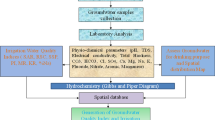Abstract
One of the greatest challenges facing by municipal engineers all over the world is condition assessment of underground water mains performance. As water mains are buried infrastructure, operated under pressure and most important it is inaccessible. In this situation, condition assessment of water mains is challenging as well as become mandatory to employ management strategies for these assets. This work presents the result of condition assessment of water mains performance by analytical hierarchy process modeling. The model was developed for data collected (2006–2011) from south-west zone of Surat city, India. The physical, operational and environmental main factors and 10 sub factors were selected to assess performance of water mains. The pair wise comparison matrices have been generated to make relative weights of each factor and their sub-factors. It represents relative importance of these factors among other factors. The pipe age is found highest relative contributing factor and pipe thickness is least relative contributing factor. The developed model generate results in terms of pipes condition on numeric scale, which is compared with linguistic scale and pipe condition is found like very risky, risky, adequate, good or excellent. The developed model is validated, which shows robust results of 86.4 %, the average validity percentage. Hence, the model is expected to benefit practitioners to prioritize rehabilitation or replacement planning for water mains.



Similar content being viewed by others
References
H. Al-Barqawi, T. Zayed, Condition rating model for underground infrastructure sustainable water mains. J. Perform. Constr. Facil. 20(2), 126–135 (2006)
Y. Kleiner, B. Rajani, “Modeling the deterioration of water mains and planning their renewal.” Infra 2002 Int. Conf. on Urban Infrastructure, 1–13, Montreal, Quebec, Canada. Infrastructure, 1–13, Montreal, Quebec, Canada, 2002
S. Christodoulou, A. Agathokleous, Proactive risk based integrity assessment of water distribution networks. J. Water Resour. Manag. Springer series (2010). Doi 10.1007/s11269-010-9629-5
A. Al-Aghbar, “Automated selection of trenchless technology for rehabilitation of water mains.” Master of Applied Science thesis, Dept. of Building, Civil, and Environmental Engineering, Concordia Univ., Montreal, 2005
H. Najjaran, R. Sadiq, B. Rajani , “Modeling pipe deterioration using soil properties—an application of fuzzy logic expert system.” Int. Conf. on Pipeline Engineering and Construction, ASCE, New York, 1–10, 2004
N. Baer, BURIED TREASURES—NRC’S Institute for Research in Construction develops new ways to evaluate the performance of underground pipes. Can. Consult. Eng. 39(2), 41–43 (1998)
U. Shamir, C. Howard, An analytical approach to scheduling pipe replacement. J. Am. Water Works Assoc. 71, 248–258 (1979)
R.M. Clark, C.L. Stafford, J.A. Goodrich, Water distribution systems: a spatial and cost evaluation. J. Water Resour. Plan. Manag. Div 108, 243–256 (1982)
S.A. Andreou, D.H. Marks, R.M. Clark, New methodology for modelling break failure patterns in deteriorating water distribution systems: applications. Adv. Water Resour. AWREDI 10, 2–10 (1987)
Y. Kleiner, B. Rajani, Using limited data to assess future needs. J. Am. Water Works Assoc. 91, 47–61 (1999)
T.D. Prasad, S.-H. Hong, N. Park, Reliability based design of water distribution networks using multi-objective genetic algorithms. KSCE J. Civ. Eng. 7(3), 351–361 (2003)
L. Tuhovcak, J. Rucka, T. Juhanak, Risk analysis of water distribution systems. In Security of water supply systems: from source to tap. NATO science for peace and security series C: environmental security, eds. by J. Pollert, B. Dedus, vol 8 (Springer, The Netherlands, 2006), pp. 169–182
Federation of Canadian Municipalities and National Research Council, “Best practices for utility-based data.” National guide to sustainable municipal infrastructure, Issue No 1.0, Ottawa, Ontario, Canada, 2003b
Federation of Canadian Municipalities and National Research Council, “Deterioration and inspection of water distribution systems”National guide to sustainable municipal Infrastructure, Issue No. 1.1, Ottawa, Ontario, Canada, 2003b
Y. Kleiner, B. Rajani, Comprehensive review of structural deterioration of water mains: statistical models. NRCC-42586. A version of this paper is published in Urban Water, vol. 3, no. 3, October, pp. 131–150 (2001)
T. Saaty, Decision Making with Dependence and Feedback: The Analytic Network Process (RWS Publications, Pittsburgh, 1991)
T. Saaty, Decision Making for Leaders: The Analytic Hierarchy Process for Decision in a complex world (Lifetime learning publications, Belmont, 1982)
T. Zayed, D. Halpin, Pile construction productivity assessment. J. Constr. Eng. Manag. 131(6), 705–714 (2005)
Acknowledgments
This work has been funded by The Institution of Engineers (India), 8 Gokhale Road, Kolkata 700020 under R&D Grant-in-Aid scheme 2010-2011.
Author information
Authors and Affiliations
Corresponding author
Rights and permissions
About this article
Cite this article
Popawala, R., Shah, N.C. Condition Assessment Model for Underground Water Mains Performance. J. Inst. Eng. India Ser. A 95, 195–201 (2014). https://doi.org/10.1007/s40030-014-0090-y
Received:
Accepted:
Published:
Issue Date:
DOI: https://doi.org/10.1007/s40030-014-0090-y




